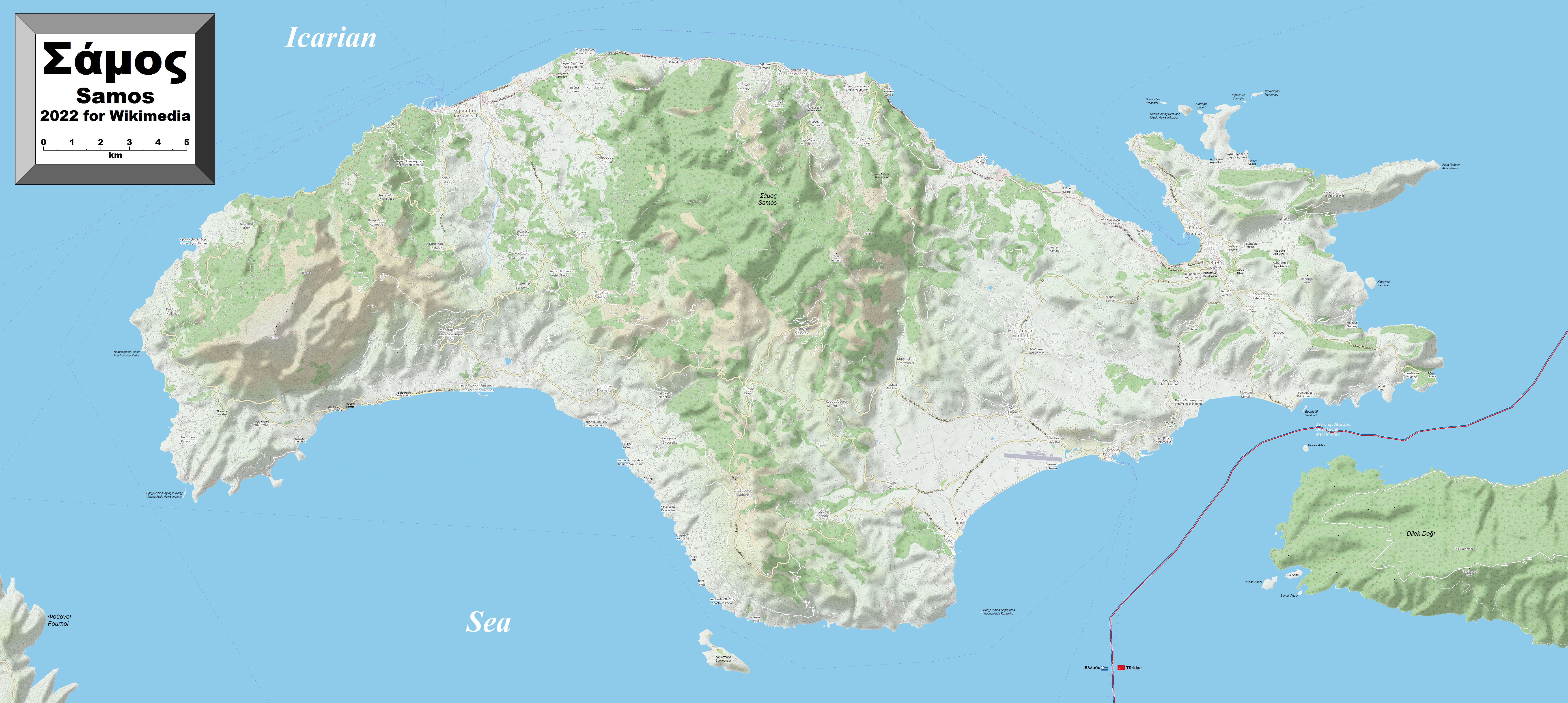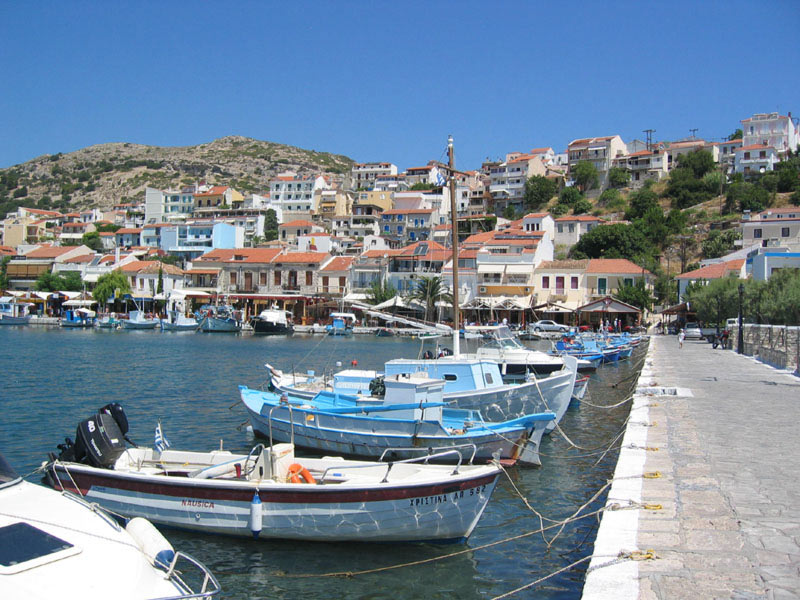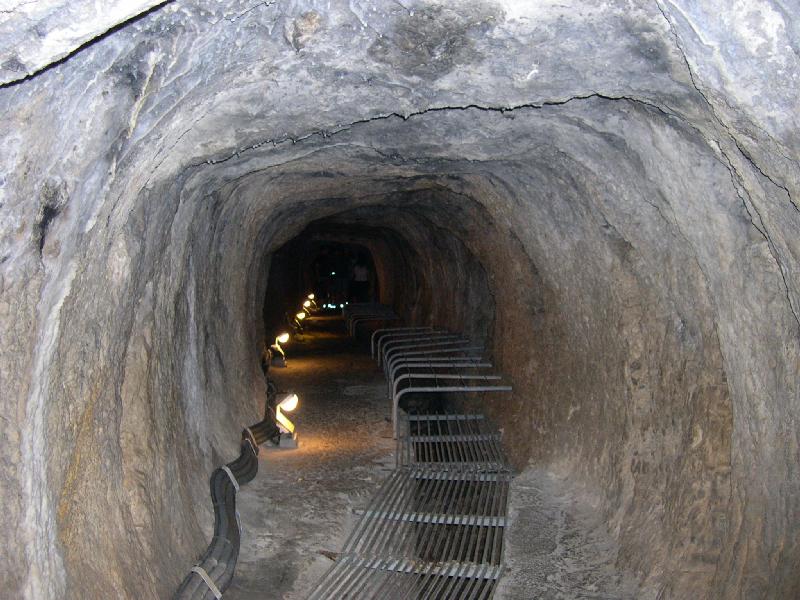|
Heraion Of Samos
The Heraion of Samos was a large sanctuary to the goddess Hera, on the island of Samos, Greece, 6 km southwest of the ancient city of Samos (modern Pythagoreion). It was located in the low, marshy basin of the Imbrasos river, near where it enters the sea. The late Archaic temple in the sanctuary was the first of the gigantic free-standing Ionic temples, but its predecessors at this site reached back to the Geometric Period of the 8th century BC, or earlier, and there is evidence of cult activities on the site from c. 1700 BC onwards. The ruins of the temple, along with the nearby archeological site of Pythagoreion, were designated UNESCO World Heritage Sites in 1992, as a testimony to their exceptional architecture and to the mercantile and naval power of Samos during the Archaic Period. History The core myth at the heart of the cult of Hera at Samos is that of her birth. According to the local tradition, the goddess was born under a ''lygos'' tree ('' Vitex agnus-castu ... [...More Info...] [...Related Items...] OR: [Wikipedia] [Google] [Baidu] |
Samos
Samos (, also ; , ) is a Greek island in the eastern Aegean Sea, south of Chios, north of Patmos and the Dodecanese archipelago, and off the coast of western Turkey, from which it is separated by the Mycale Strait. It is also a separate regional unit of the North Aegean region. In ancient times, Samos was an especially rich and powerful city-state, particularly known for its vineyards and wine production. It is home to Pythagoreion and the Heraion of Samos, a UNESCO World Heritage Site that includes the Eupalinian aqueduct, a marvel of ancient engineering. Samos is the birthplace of the Greek philosopher and mathematician Pythagoras, after whom the Pythagorean theorem is named, the philosophers Melissus of Samos and Epicurus, and the astronomer Aristarchus of Samos, the first known individual to propose that the Earth revolves around the Sun. Samian wine was well known in antiquity and is still produced on the island. The island was governed by the semi-autonomous P ... [...More Info...] [...Related Items...] OR: [Wikipedia] [Google] [Baidu] |
Vitex Agnus-castus
''Vitex agnus-castus'' (also called vitex, chaste tree / chastetree, chasteberry, Abraham's balm, lilac chastetree, or monk's pepper) is a plant native of the Mediterranean region. It is one of the few temperate-zone species of ''Vitex'', which is on the whole a genus of tropical and subtropical flowering plants.David J. Mabberley. 2008. ''Mabberley's Plant-Book'' third edition (2008). Cambridge University Press: UK. Vitex is a cross-pollinating plant, but its self-pollination has been recorded.Verein für Arznei- und Gewürzpflanzen Saluplanta. 2013. ''Handbuch des Arznei- und Gewürzpflanzenbaus'' volume 5 Arznei- und Gewürzpflanzen L–Z, pages 192–199. Verein für Arznei- und Gewürzpflanzen Saluplanta: Bernburg, Germany. (set). Theophrastus mentioned the shrub several times, as ''agnos'' (ἄγνος) in ''Enquiry into Plants''. It has been long believed to be an anaphrodisiac – leading to its name as "chaste tree" – but its effectiveness for such action re ... [...More Info...] [...Related Items...] OR: [Wikipedia] [Google] [Baidu] |
Classical Greece
Classical Greece was a period of around 200 years (the 5th and 4th centuries BC) in ancient Greece,The "Classical Age" is "the modern designation of the period from about 500 B.C. to the death of Alexander the Great in 323 B.C." ( Thomas R. Martin, ''Ancient Greece'', Yale University Press, 1996, p. 94). marked by much of the eastern Aegean and northern regions of Greek culture (such as Ionia and Macedonia) gaining increased autonomy from the Persian Empire; the peak flourishing of democratic Athens; the First and Second Peloponnesian Wars; the Spartan and then Theban hegemonies; and the expansion of Macedonia under Philip II. Much of the early defining mathematics, science, artistic thought (architecture, sculpture), theatre, literature, philosophy, and politics of Western civilization derives from this period of Greek history, which had a powerful influence on the later Roman Empire. Part of the broader era of classical antiquity, the classical Greek era ended after ... [...More Info...] [...Related Items...] OR: [Wikipedia] [Google] [Baidu] |
Polycrates
Polycrates (; ), son of Aeaces (father of Polycrates), Aeaces, was the tyrant of Samos from the 540s BC to 522 BC. He had a reputation as both a fierce warrior and an enlightened tyrant. Sources The main source for Polycrates' life and activities is the historian Herodotus, who devotes a large section of book 3 of his ''Histories (Herodotus), Histories'' to the rise and fall of Polycrates (3.39-60, 3.120-126). His account was written in the third quarter of the 5th century BC, nearly a century after Polycrates' death, was based mostly on oral traditions and incorporates many folk-tale elements. Furthermore, Herodotus creatively shaped his account of Polycrates in order to make general moral points and to comment on the imperialism of the Athenian empire in his own day. Some poetry from Polycrates' time comments on him in passing and there is a smattering of references to Polycrates in other literary sources ranging in date from the 4th century BC to the Roman Empire, Roman Impe ... [...More Info...] [...Related Items...] OR: [Wikipedia] [Google] [Baidu] |
Kouroi
Kouros (, , plural kouroi) is the modern term given to free-standing Ancient Greek sculptures that depict nude male youths. They first appear in the Archaic period in Greece and are prominent in Attica and Boeotia, with a less frequent presence in many other Ancient Greek territories such as Sicily. Such statues are found across the Greek-speaking world; the preponderance of these were found in sanctuaries of Apollo with more than one hundred from the sanctuary of Apollo Ptoion, Boeotia, alone. These free-standing sculptures were typically marble, but the form is also rendered in limestone, wood, bronze, ivory and terracotta. They are typically life-sized, though early colossal examples are up to 3 meters tall. The female sculptural counterpart of the kouros is the kore. Etymology The Ancient Greek word kouros () refers to "youth, boy, especially of noble rank." When a pubescent was received into the body of grown men, as a grown ''Kouros'', he could enter the initiation fes ... [...More Info...] [...Related Items...] OR: [Wikipedia] [Google] [Baidu] |
Helladic Period
Helladic chronology is a relative dating system used in archaeology and art history. It complements the Minoan chronology scheme devised by Sir Arthur Evans for the categorisation of Bronze Age artefacts from the Minoan civilization within a historical framework. Whereas Minoan chronology is specific to Crete, the cultural and geographical scope of Helladic chronology is confined to mainland Greece during the same timespan (c. 3200 – c. 1050 BC). Similarly, a Cycladic culture, Cycladic chronology system is used for artifacts found in the Aegean Sea, Aegean islands. Archaeological evidence has shown that, broadly, civilisation developed concurrently across the whole region and so the three schemes complement each other chronologically. They are grouped together as "Aegean" in terms such as Aegean art and, rather more controversially, Aegean civilization. The systems derive primarily from changes in the style of pottery, which is a benchmark for relative dating of associated arti ... [...More Info...] [...Related Items...] OR: [Wikipedia] [Google] [Baidu] |
Early Bronze Age
The Bronze Age () was a historical period characterised principally by the use of bronze tools and the development of complex urban societies, as well as the adoption of writing in some areas. The Bronze Age is the middle principal period of the three-age system, following the Stone Age and preceding the Iron Age. Conceived as a global era, the Bronze Age follows the Neolithic, with a transition period between the two known as the Chalcolithic. The final decades of the Bronze Age in the Mediterranean basin are often characterised as a period of widespread societal collapse known as the Late Bronze Age collapse (), although its severity and scope are debated among scholars. An ancient civilisation is deemed to be part of the Bronze Age if it either produced bronze by smelting its own copper and alloying it with tin, arsenic, or other metals, or traded other items for bronze from producing areas elsewhere. Bronze Age cultures were the first to History of writing, develop writin ... [...More Info...] [...Related Items...] OR: [Wikipedia] [Google] [Baidu] |
Periegesis Of Greece
''Description of Greece'' () is the only surviving work by the ancient "geographer" or tourist Pausanias (c. 110 – c. 180). Pausanias' ''Description of Greece'' comprises ten books, each of them dedicated to some part of mainland Greece. He is essentially describing his own travels, and large parts of Greece are not covered, including the islands. His tour begins in Attica () and continues with Athens, including its suburbs or demes. Then the work goes with Corinthia (), Laconia (), Messenia (), Elis (), Achaea (), Arcadia (), Boeotia (), Phocis (), and Ozolian Locris (). The work is rather erratic on described topography; its main interest is the cultural geography of ancient Greece, especially its religious sites, in which Pausanias not only mentioned, and occasionally described, architectural and artistic objects, but also reviewed the historical and mythological underpinnings of the culture that created them. Recent decades, during which archaeology has confirmed ... [...More Info...] [...Related Items...] OR: [Wikipedia] [Google] [Baidu] |
Pythagoreio
Pythagoreio () is a town and municipal unit on the island of Samos, North Aegean, Greece. Before the 2011 local government reform, Pythagoreio was a municipality. Since 2019, it is a municipal unit of East Samos. In 2021, the town's population was 7,515. It is the largest municipal unit in land area on Samos, at . It shares the island with the municipal units of Vathy, Karlovasi, and Marathokampos. The archaeological remains in the town, known collectively as Pythagoreion, has designated a joint UNESCO World Heritage Site with nearby Heraion. The seat of the municipality was the town of Pythagorio, formerly known as Tigani. The town was renamed in 1955 to honour the locally born mathematician and philosopher Pythagoras. The port of the town is considered to be the oldest man-made port of the Mediterranean Sea. History Pythagorio is built on the ancient city of Samos. Some ruins of the ancient city are today incorporated in modern houses of Pythagorio. The ancient city reach ... [...More Info...] [...Related Items...] OR: [Wikipedia] [Google] [Baidu] |
Ancient Harbour Of Samos
The ancient harbour of Samos was located at the town of Samos (modern Pythagoreio) on the island of Samos. It consisted of a large mole, which was identified in the fifth century BC ancient Greek historian Herodotus as one of three greatest feats of engineering in the Greek world.Herodotus, ''Histories'' 3.60 Large parts of the ancient mole seem to survive, partially incorporated into the modern mole, but these remains are very difficult to date. History The island of Samos became one of the major naval powers in the Aegean in the sixth century BC, culminating in the reign of the tyrant Polycrates. In the fifth century, Herodotus reports a mole surrounded the harbour, with a length of more than two stades out to sea (over 400 metres), and reached a depth of twenty orguia (c. 20 metres). The island's political power declined in the fifth century BC. However, the harbour continued to be a major naval base and an important economic hub, especially under Ptolemaic rule during the He ... [...More Info...] [...Related Items...] OR: [Wikipedia] [Google] [Baidu] |
Tunnel Of Eupalinos
The Tunnel of Eupalinos or Eupalinian aqueduct () is a tunnel of length running through Mount Kastro in Samos Island, Samos, Greece, built in the 6th century BC to serve as an Aqueduct (water supply), aqueduct. The tunnel is the second known tunnel in history which was excavated from both ends (, "having two openings"), and the first with a geometry-based approach in doing so. Today it is a popular tourist attraction. The tunnel is inscribed on the UNESCO World Heritage List along with the nearby Pythagoreion and Heraion of Samos, and it was designated as an List of Historic Civil Engineering Landmarks, International Historic Civil Engineering Landmark in 2017. Early history The Eupalinian aqueduct is described by Herodotus (''Histories'' 3.60): :I have dwelt longer upon the history of the Samians than I should otherwise have done, because they are responsible for three of the greatest building and engineering feats in the Greek world: the first is a tunnel nearly a mile long, ... [...More Info...] [...Related Items...] OR: [Wikipedia] [Google] [Baidu] |
Herodotus
Herodotus (; BC) was a Greek historian and geographer from the Greek city of Halicarnassus (now Bodrum, Turkey), under Persian control in the 5th century BC, and a later citizen of Thurii in modern Calabria, Italy. He wrote the '' Histories'', a detailed account of the Greco-Persian Wars, among other subjects such as the rise of the Achaemenid dynasty of Cyrus. He has been described as " The Father of History", a title conferred on him by the ancient Roman orator Cicero, and the " Father of Lies" by others. The ''Histories'' primarily cover the lives of prominent kings and famous battles such as Marathon, Thermopylae, Artemisium, Salamis, Plataea, and Mycale. His work deviates from the main topics to provide a cultural, ethnographical, geographical, and historiographical background that forms an essential part of the narrative and provides readers with a wellspring of additional information. Herodotus was criticized in his times for his inclusion of "legends an ... [...More Info...] [...Related Items...] OR: [Wikipedia] [Google] [Baidu] |







